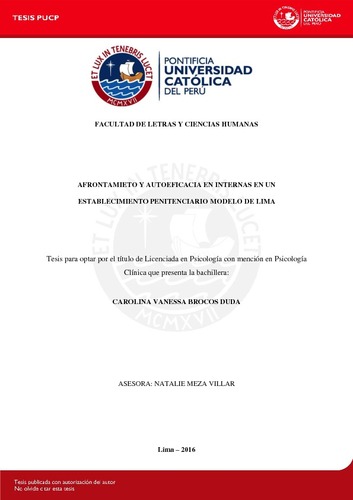| dc.contributor.advisor | Meza Villar, Sonia Natalie | es_ES |
| dc.contributor.author | Brocos Duda, Carolina Vanessa | es_ES |
| dc.date.accessioned | 2016-07-06T18:50:03Z | es_ES |
| dc.date.available | 2016-07-06T18:50:03Z | es_ES |
| dc.date.created | 2016 | es_ES |
| dc.date.issued | 2016-07-06 | es_ES |
| dc.identifier.uri | http://hdl.handle.net/20.500.12404/7084 | |
| dc.description.abstract | En la presente investigación se describió la relación entre la autoeficacia y el afrontamiento en 110 adultas jóvenes con edades que fluctuaban entre los 20 y 40 años (M = 31.08, DE = 5,58), internas en un establecimiento penitenciario modelo de Lima. Para este propósito, se utilizó la adaptación al español de la Escala de autoeficacia general (EAG) de Baessler y Schwarzer (1996) y el Cuestionario de estimación del afrontamiento (COPE) de Carver, Schreier & Weintraub (1989). Se encontró que existe una relación positiva y significativa entre autoeficacia y el estilo enfocado en el problema y el estilo enfocado en la emoción. Por último, se encontraron diferencias significativas en el afrontamiento según grado de instrucción, si la persona tiene pareja, nivel de seguridad del pabellón, asistencia a terapia psicológica y tiempo de sentencia. No se encontraron diferencias al comparar los grupos según autoeficacia. | es_ES |
| dc.description.abstract | The present study described the relationship between self efficacy and coping in 110 young adult female inmates with ages between 20 and 40 (M = 31.08, SD = 5.58). The spanish adaptation of the General self efficacy Scale (GSE) of Baessler and Schwarzer (1996) and the COPE inventory of Carver, Schreier & Weintraub (1989) were used for this purpose. It was found that there is a positive and significant relationship between self-efficacy and problem-focused style and emotion focused style. Finally, significant differences were found in coping according to the level of education, couple status, security level of the unit, assistance to psychological therapy and time of sentence. No differences were found when comparing the groups according to self-efficacy. | es_ES |
| dc.language.iso | spa | es_ES |
| dc.publisher | Pontificia Universidad Católica del Perú | es_ES |
| dc.rights | Atribución-NoComercial-SinDerivadas 2.5 Perú | * |
| dc.rights | info:eu-repo/semantics/openAccess | es_ES |
| dc.rights.uri | http://creativecommons.org/licenses/by-nc-nd/2.5/pe/ | * |
| dc.subject | Adaptación (Psicología) | es_ES |
| dc.subject | Autoeficacia | es_ES |
| dc.subject | Prisiones--Mujeres. | es_ES |
| dc.subject | Adultos jóvenes. | es_ES |
| dc.title | Afrontamiento y autoeficacia en internas en un establecimiento penitenciario modelo de Lima | es_ES |
| dc.type | info:eu-repo/semantics/bachelorThesis | es_ES |
| thesis.degree.name | Licenciado en Psicología Clínica | es_ES |
| thesis.degree.level | Título Profesional | es_ES |
| thesis.degree.grantor | Pontificia Universidad Católica del Perú. Facultad de Letras y Ciencias Humanas. | es_ES |
| thesis.degree.discipline | Psicología Clínica | es_ES |
| renati.discipline | 313026 | es_ES |
| renati.level | https://purl.org/pe-repo/renati/level#tituloProfesional | es_ES |
| renati.type | http://purl.org/pe-repo/renati/type#tesis | es_ES |
| dc.publisher.country | PE | es_ES |
| dc.subject.ocde | https://purl.org/pe-repo/ocde/ford#5.01.00 | es_ES |






